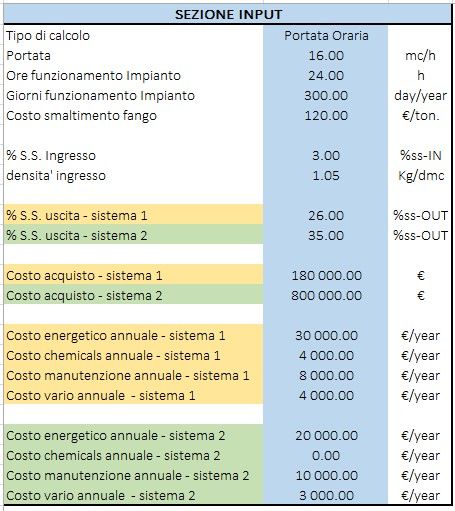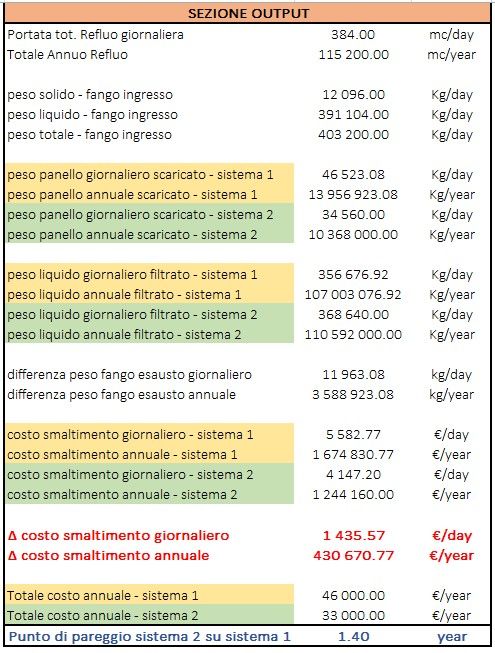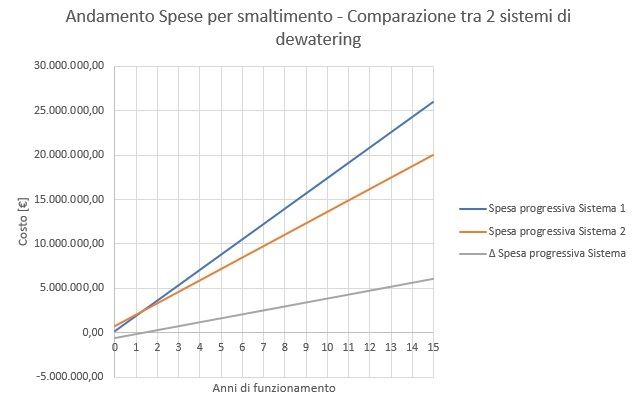A very important reflection that we must always make when we evaluate the choice between sludge dewatering with filter presses or other systems on the market, is an economic comparative analysis between the various options involved.
As we well know, there are many sludge dewatering systems, among the best known there are certainly plate filter presses, belt filter presses (or belt presses) and centrifuges.
Although each machine has advantages and disadvantages, it is advisable to weigh all the economic aspects in terms of:
– Cost of first purchase
– Energy costs (to use the dewatering equipments)
– Annual maintenance costs
– Operating costs (consumption of chemicals, utilities such as water, air, etc…)
– Cost of sludge disposal deriving from the chosen type of dehydration.
This is essential as each system must be balanced according to the customer’s needs and above all according to the plant’s own data
This is just one of the cases that we have seen with one of our customers who had a sludge dewatering system with a filter press consisting of 2 units (2 filters in all).
In this case, the filter press feed pumps, which were membrane pumps, were replaced with variable displacement piston pumps.
The diaphragm pumps that were present had an installed power of 18.5 kW and were able to feed the filter presses only at a pressure of 10 bar.
With the Dragon series pumps with hydraulic control and variable flow rate, with only 7.5 kW of installed power, we were able to feed the filter press at 13 bar.
So there was a clear improvement in energy expenditure but above all the significant improvement was obtained in the output dry content, as with the pump alone we went from 40% of dry matter to DM. out at 45%.
Now the question is: how much does that 5% change in the output dry solid affect?

Let’s make a couple of calculations using this customer’s data: currently a quantity of residual cake of around 30 ton/day is disposed of and the average disposal cost of this dehydrated sludge is 150 €/ton.
The inlet sludge is about 3%, while the outlet sludge is 40%.
The hourly flow rate is approximately 16 m3/h for 24h/day, the density of the incoming sludge is approximately 1.05 kg/dm3.
Daily flow = 16 m3/h * 24 h/day = 384 m3/day
Inlet sludge weight = 384 m3/day * 1,050 kg/mc = 403,200 kg/day of inlet sludge
Of which 3% dry: 403,200 kg/day * 3% = 12,096 kg/day dry.
With a panel at 40% we obtain:
12,096 Kg/day * 100 /40 = 30,240 Kg/day of exhausted panel to be disposed of
The plant works 24 hours a day for about 320 days a year.
So with a quick calculation we can say that every year the following are disposed of:
30.24 ton/day * 320 day/year = 9,676.80 ton / year of sludge disposed at a price of:
150 €/ton * 9,676.80 ton/year = 1,451,520 €/year of sludge disposal cost.
Let’s see how much less sludge I dispose of due to a 5 percentage point higher concentration of dry output:
With a panel at 45% we obtain:
12,096 Kg/day * 100 /45 = 26,880 Kg/day of exhausted panel to be disposed of,
which annually correspond to:
26.88 ton/day * 320 day/year = 8,601.60 ton / year of sludge disposed at a price of:
150 €/ton * 8,601.60 ton/year = 1,290,240 €/year of sludge disposal cost
With an annual saving of:
€1,451,520/year – €1,290,240/year = €161,280/year
And daily of:
161,280 €/year / 320 days/year = 504 €/day
and 3.36 ton/day of “water” saved.
So, in this case, a 5% change in the dry content saves approximately €161,280 in disposal costs which correspond to 11.1% of the current disposal expenditure.
It is therefore evident that this is an investment that has a significant leverage effect, and in this perspective, we can evaluate the time in which I arrive at the “break-even point”.
Suppose that the pumps cost 30,000 €/each, this investment to change 2 pumps is amortized in:
(60,000 / 161,280) * 12 = 4.46 months.
In reality, if we consider the lower energy cost of the two pumps with less than half power, the time is even shorter, because in this simplified calculation I do not take into account the management costs seen in the previous points.
However, if we wanted to evaluate which investment to make between two dehydration systems and we wanted to consider everything (obviously these are simplified preliminary calculations) we would have to calculate all the items and compile a table like the one below:

In this case we have entered invented purchase and energy expenditure values, but we still need them to understand the concept and analyse the result trend.
In fact, we have considered 2 distinct dewatering systems, namely:


We see the variation of the years of plant operation, let’s see how the projection would be in the 2 different solutions:

As you can easily see, the two systems break even after about 1 year and a half, starting from which system 2 becomes much more advantageous than system 1, as it allows me to save €430,670 each year.
Thus, although system 2 costs more than 4 times system 1, the difference in performance between the 2 systems has a significant amplifying effect over time.
Clearly these data are invented and the slope of the lines is a function of the cost of sludge disposal, but the important concept is that the purchase cost affects in a way that must be related to its performance, especially over a long-time horizon.
It is therefore always necessary to carry out an accurate analysis before discarding a sludge dehydration system with a filter press and opting for an apparently cheaper one: I could find that in the long run I would spend much more!